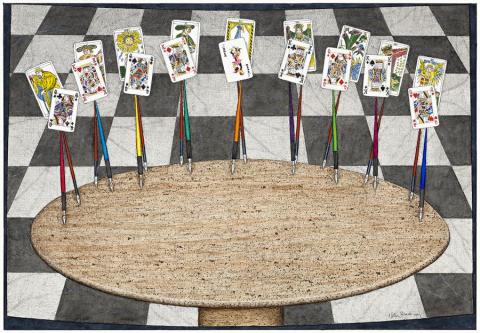THE PERFORMANCE, 1989
JOHN BRACK
watercolour, pen and ink on paper
69.0 x 99.0 cm
signed and dated lower right: John Brack / 1989
Private collection, Melbourne
A Question of Balance: John Brack 1974–1994, Heide Museum of Modern Art, Melbourne, 1 April – 28 May 2000
John Brack, National Gallery of Victoria, Melbourne, 24 April – 9 August 2009 (label attached verso)
Grishin, S., The Art of John Brack, Oxford University Press, Melbourne, 1990, vol. II, cat. p308, p. 74
Grant, K., John Brack, National Gallery of Victoria, Melbourne, 2009, p. 199 (illus.)
Widely acclaimed among his most overtly analytical achievements, Brack's complex 'pencil series' offers an intriguing commentary on public regimentation and social homogeneity in the guise of military manoeuvres and battle scenes populated by the simple everyday materials of the artist. In these grand meditations upon the nature of history, humanity and civilisation, 'the pencils and pens stand as metaphors as much for soldiers and their commanders as for office workers and their chiefs, or any other grouping. Once a grouping has formed, then rivalry and opposition seem inevitable.'1 Having created an emotional neutrality, an art free of passionate impulses, each painting here represents 'a beautifully thought-through step'; as Grishin continues, 'this is arguably the most intensely deliberate of all his series and also one that presents fewest parallels in contemporary art.'2
Elucidating the complex iconography of the present work, indeed Helen Brack suggests, "In this picture, The Performance, one aspect of our being, John has used our inherited symbolism, still used in the pack of cards - the Kings and Queens, the rulers, the parents, the tribes. Each tribe has its traditional implication - hearts, diamonds, clubs and the evil spades. The performance is the dance of coupled pens, the back ones all straight in shape and coloured a dark hot red with nibs that are straight and rectangular, the front pens all tapered in shape and in different, almost iridescent colours, and with bulbous shaped nibs. All the nibs glitter and the pen holders are black, a black that links to the dark squares of the floor, to the black cards, and to the black space behind the whole tableau. These performers are people who rule and enforce.
The back pens hold the Tarot cards, whose meaning is visually symbolic and still valid. Each front pen has a King or a Queen, with a tarot card a halo or shadow behind it - all cards, tarot and court, facing us, the viewers. Each card is an exact copy of a real card, John having made detailed tracings of each real one. Thus he revisits the issue of real or replicated, of simulation - are the cards real or are they exact replicas?
The black Queen of clubs is held by a rich red pen, and the Hermit card is behind her. The red King of Hearts has a rich cerulean blue pen, and his companion is The Magician. The red King of Diamonds has Justice, the Queen of Diamonds, The Tower, and so on. Part of the multi-dimensionality of John's pictures is the inclusion of meaning, via our inherited visual language - in theatre it is the language of mime that corresponds. Our thinking mind is part of the content of John's pictures, as well as our clever hands.
In these late pictures, John has often as here projected the table outside the picture plane, placing the front curve between the front of the picture and the viewer - like Chardin with his projecting knife - so that the action, the dancing, starts at the picture plane itself, thus including us, the viewers, in this 'performance'...
We are grateful to Helen Brack for her assistance with this catalogue essay.
1. Grishin, S., The Art of John Brack, Oxford University Press, Melbourne, 1990, vol. I, p. 146
2. ibid., p. 145
VERONICA ANGELATOS
